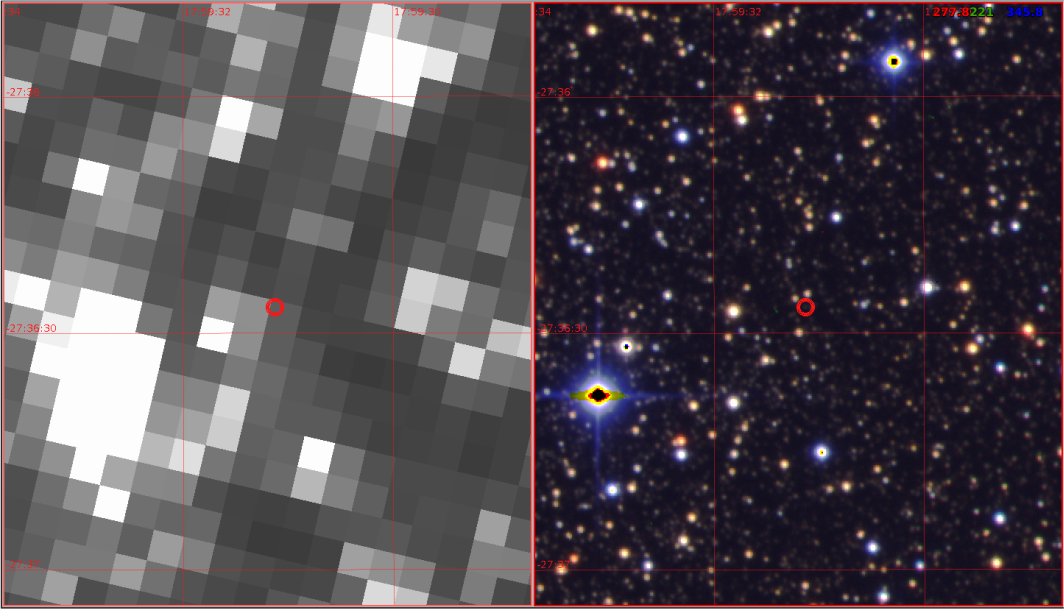An international team of astrophysicists guided by the Jodrell Bank Centre for Astrophysics has announced the astonishing discovery of a near-identical twin of Jupiter orbiting a star 17,000 light-years away from Earth.
 The view of the region close to the Galactic Centre centered where the planet was found. The two images show the region as seen by Kepler (left) and by the Canada-France-Hawaii Telescope (CFHT) from the ground. The planet is not visible but its gravity affected the light observed from a faint star at the center of the image (circled). Kepler’s very pixelated view of the sky required specialized techniques to recover the planet signal. Image Credit: The University of Manchester.
The view of the region close to the Galactic Centre centered where the planet was found. The two images show the region as seen by Kepler (left) and by the Canada-France-Hawaii Telescope (CFHT) from the ground. The planet is not visible but its gravity affected the light observed from a faint star at the center of the image (circled). Kepler’s very pixelated view of the sky required specialized techniques to recover the planet signal. Image Credit: The University of Manchester.
The exoplanet, K2-2016-BLG-0005Lb, is nearly identical to Jupiter in terms of mass and distance from the sun. It was identified using data from NASA’s Kepler space telescope collected in 2016. The exoplanet system is twice as far away as any previously discovered by Kepler, which identified over 2,700 confirmed planets before shutting down in 2018.
The planet was discovered utilizing gravitational microlensing, a prediction of Einstein’s Theory of Relativity, and is the first planet discovered in this manner from space. The research has been published in the Monthly Notices of the Royal Astronomical Society journal.
The lead author of the study, David Specht, is a Ph.D. student at The University of Manchester. To discover an exoplanet employing the microlensing effect, the team looked through Kepler data from April to July 2016, when the spacecraft was regularly monitoring millions of stars near the Galaxy’s center.
The goal was to see if an exoplanet and its host star could bend and magnify light from a background star as it passed through the line of sight.
To see the effect at all requires almost perfect alignment between the foreground planetary system and a background star. The chance that a background star is affected this way by a planet is tens to hundreds of millions to one against. But there are hundreds of millions of stars towards the center of our Galaxy. So Kepler just sat and watched them for three months.
Dr. Eamonn Kerins, Principal Investigator, Science and Technology Facilities Council
The study was financially supported by the Science and Technology Facilities Council (STFC) grant.
Candidate signals were finally discovered last year using a novel search algorithm described in a study headed by Dr. Iain McDonald, an STFC-funded postdoctoral researcher at the time, working with Dr. Kerins. One of the five new candidate microlensing signals found in that analysis clearly indicated an anomaly consistent with the presence of an orbiting exoplanet.
At the same time as Kepler, five international ground-based surveys looked at the same area of sky. At a distance of around 135 million km from Earth, Kepler noticed the anomaly way sooner and for a longer period of time than the Earth-based teams. The recent study models the consolidated datasets comprehensively, concluding that the signal is caused by a distant exoplanet.
Dr. Kerins remarks, “The difference in vantage point between Kepler and observers here on Earth allowed us to triangulate where along our sight line the planetary system is located.”
Kepler was also able to observe uninterrupted by weather or daylight, allowing us to determine precisely the mass of the exoplanet and its orbital distance from its host star. It is basically Jupiter's identical twin in terms of its mass and its position from its Sun, which is about 60% of the mass of our own Sun.
Dr. Eamonn Kerins, Principal Investigator, Science and Technology Facilities Council
NASA will launch the Nancy Grace Roman Space telescope later this decade. Roman, using the microlensing method, will identify potentially thousands of distant planets. The European Space Agency’s Euclid mission, which is due to launch next year, could also undertake a microlensing exoplanet search as an additional science activity.
Dr. Kerins is also the Deputy Lead for the ESA Euclid Exoplanet Science Working Group.
Kepler was never designed to find planets using microlensing so, in many ways, it's amazing that it has done so. Roman and Euclid, on the other hand, will be optimized for this kind of work. They will be able to complete the planet census started by Kepler.
Dr. Eamonn Kerins, Principal Investigator, Science and Technology Facilities Council
“We'll learn how typical the architecture of our own solar system is. The data will also allow us to test our ideas of how planets form. This is the start of a new exciting chapter in our search for other worlds,” concludes Dr. Kerins.
An animation of the gravitational lensing signal from Jupiter twin K2-2016-BLG-0005Lb. The local star field around the system is shown using real color imaging obtained with the ground-based Canada-France-Hawaii Telescope by the K2C9-CFHT Multi-Color Microlensing Survey team. The star indicated by the pink lines is animated to show the magnification signal observed by Kepler from space. The trace of this signal with time is shown in the lower right panel. On the left is the derived model for the lensing signal, involving multiple images of the star caused by the gravitational field of the planetary system. The system itself is not directly visible. Video Credit: The University of Manchester.
Journal Reference:
Specht, D., et al. (2022) Kepler K2 Campaign 9: II. First space-based discovery of an exoplanet using microlensing. Monthly Notices of the Royal Astronomical Society. doi.org/10.48550/arXiv.2203.16959.